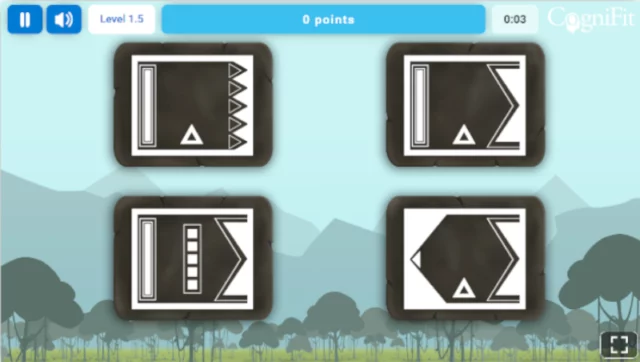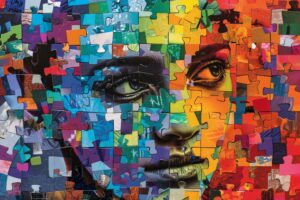
Piece Making Game – Brain Targeting Pictures
If you feel like a brain game with just pictures, then the Piece Making game is for you! Let’s take a look at how it works on easy and difficult levels. We will also go over what brain functions it targets and how the game related to them.
Playing Piece Making Game
With all CogniFit games, you’ll start out with a quick tutorial to give you the basics. Then, you’ll dive right in. This one comes with a short video from one of our wellness coaches too.
The basic premise is that you’ll see three, separate images on the screen. They come in the form of rectangles with a black and white graphic inside. Then, they will disappear.

But…
When they reappear, you’ll have FOUR different choices, and only one will be correct. Also, instead of separated rectangles, the graphics are now sitting side by side to form a single image. And, as levels progress, you’ll have less time to memorize what you see, and the images will sit at different distances apart.

What Does Piece Making Game Target?
Recognition
“Recognition could be defined as the brain’s ability to identify stimuli, like situations, places, people, objects, etc. that you have seen before.”
Without it, we wouldn’t be able to recover stored information or compare it to new/old information that’s right in front of us. This type of memory can also be called “Recovery” and can come in different forms…
- Open Memory: After looking at a list of words, you repeat them. Think of the stuff you used to do in school. Like geography answers or animal names.
- Serial Memory: Having to repeat a list of words or steps from memory but in the same order. This is useful for things like recipes or instructions.
- Keyword: The person gets clues to help them remember the list of words. These could be synonyms, semantic or phonological pairings, or memory triggers.
For us to have Recognition, we have to have seen the “stimuli” before. But what’s really interesting is that we can have “false” recoveries as well.
- False Positive – When we think we remember something, but we’ve never actually seen it before.
- False Negative – We’ve seen something before but don’t remember it.
The goal is to have more accurate reactions than false ones because we use this cognitive ability every day – for things like our jobs, studying, driving, meeting people we know, etc.
Piece Making uses images to force you to use your Recognition skills (in the second half where you have to recall what you just saw.
Visual Perception
This brain function is very unique, but something all of us take for granted. This complex process lets us understand the world around us. Without it, we would be able to comprehend things like shape, size, dimension, measurements, color, lighting, use, name, or personal relationship, etc.
Let’s say you want to get a pen to sign your name on a document. Your brain needs to see the pen, but then understand all of its characteristics so you know it’s a pen. You see the length, the material, the ink inside, the cap, etc. Then you see the pile of papers, the letter (Visual Perception also allows us to understand reading/writing language).
In the Piece Making game, you have to distinguish different shapes and black/white color patterns. This triggers your Visual Perception.

Visual Short-Term Memory
We’ve all heard of Short-Term Memory – STM. Well, Visual STM is just a sub-function (the visual component, obviously). And while we all wish for better memory, there is one very interesting thing about this particular kind of memory.
It’s limited … for everyone.
Yep. No matter how hard you exercise this, it’s always going to have a cap (around 5 to 9 elements). There are of course tricks and skills to make VSTM more efficient (and we could all do with brain training in this area). But it’s meant to be temporary. It’s a place for our brains to store things for two reasons.
First, we only need the data for a short while.
For example, you won’t need to remember that bananas were on sale for 50% off on January 8th, 2019. You only need to remember that during that very moment while you were mentally doing your budget. After, you forgot it (as you should).
Second, the information you learned was vital and it needed to be moved into long-term memory. Things like birthdays, anniversaries, etc. Whatever information we need to keep, goes through other processes to stay with us for the long term.
Since it’s data we don’t need to retain (and we know that), our brains use our Short-Term Visual Memory (because of the images).
Piece Making Game Conclusion
Seeing a difference in brain exercises only takes three weekly sessions and 20 minutes per session. But to keep things interesting, it’s essential to have a rotation of games that not only target areas that are important to you, but that are fun yet challenging enough (that you don’t get frustrated).
Piece Making is a more calming game you might enjoy. You can also visit CogniFit.com to see other great brain games!
Disclaimer: CogniFit’s cognitive training and assessment tools are designed to promote cognitive stimulation and mental engagement. They are not intended to diagnose, treat, or prevent any medical condition. All information presented here is for educational and informational purposes only and should not replace professional healthcare advice.
The information in this article is provided for informational purposes only and is not medical advice. For medical advice, please consult your doctor.














